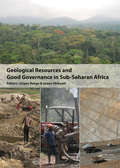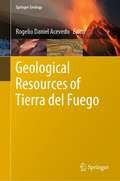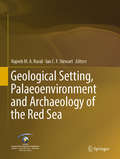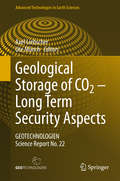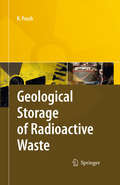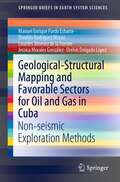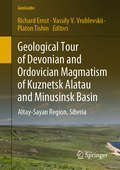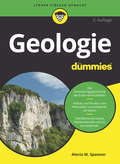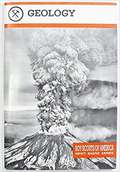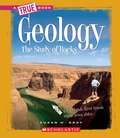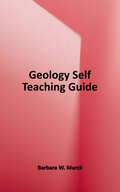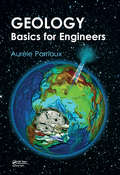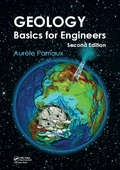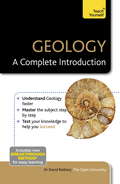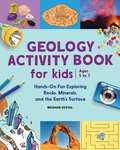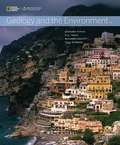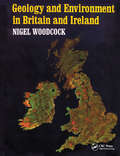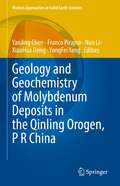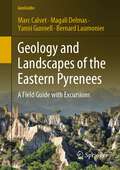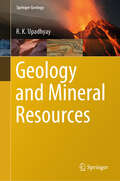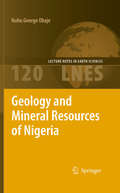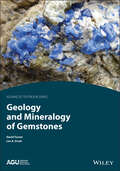- Table View
- List View
Geological Resources and Good Governance in Sub-Saharan Africa: Holistic Approaches to Transparency and Sustainable Development in the Extractive Sector
by Jürgen Runge James ShikwatiThis book looks at the distribution, occurrences, potential and prospects for good governance, transparency and sustainable development of geological resources in Sub-Saharan Africa. By bringing together numerous different point of views, it is carried out in a holistic, interdisciplinary and scientific way.The states of Sub-Saharan Africa are amon
Geological Resources of Tierra del Fuego (Springer Geology)
by Rogelio Daniel AcevedoThe CADIC’s Geological Resources Program will soon turn 40 years of fruitful development. During this period many projects were carried out and others remain to be implemented. In the course of time three generations of researchers have been formed. Mentioning names would be unfair to those that could be involuntarily omitted. There is still a long way to go. The eagerness for knowledge should not stop. This book is a tribute to all those people who have worked in the different projects of pure and applied science, and educational, and human resources training, granted to this founding program and associated laboratories of the regional center of CONICET in Ushuaia, Tierra del Fuego, Argentina. The twenty papers which constitute this book have a genuine Latin appeal, having been written by 50 authors based in Argentina and Spain. All this contributions are concerned with Fuegian geological resources. Everyone concerned with this work hopes that it will prove a fitting and lasting memorial to Nacho Subías, whose personal contribution to our knowledge of this geology was outstanding.
Geological Setting, Palaeoenvironment and Archaeology of the Red Sea (Environmental Earth Sciences Ser.)
by Najeeb M.A. Rasul Ian C.F. StewartThis book gathers invited contributions from active researchers to provide an up-to-date overview of the geological setting of the Red Sea. It discusses aspects ranging from historical information to modern research in the Red Sea, and presents findings from rapidly advancing, emerging fields. This semi-enclosed young ocean basin provides a unique opportunity to study the development of passive continental margins in order to examine the current status of that region. In addition to studies on the Sea itself, it includes those from related fields on the littoral zone. The book is of interest to geoscientists and non-specialists alike.
Geological Storage of CO2 - Long Term Security Aspects
by Axel Liebscher Ute MünchThis book explores the industrial use of secure, permanent storage technologies for carbon dioxide (CO2), especially geological CO2 storage. Readers are invited to discover how this greenhouse gas could be spared from permanent release into the atmosphere through storage in deep rock formations. Themes explored here include CO2 reservoir management, caprock formation, bio-chemical processes and fluid migration. Particular attention is given to groundwater protection, the improvement of sensor technology, borehole seals and cement quality. A collaborative work by scientists and industrial partners, this volume presents original research, it investigates several aspects of innovative technologies for medium-term use and it includes a detailed risk analysis. Coal-based power generation, energy consuming industrial processes (such as steel and cement) and the burning of biomass all result in carbon dioxide. Those involved in such industries who are considering geological storage of CO2, as well as earth scientists and engineers will value this book and the innovative monitoring methods described. Researchers in the field of computer imaging and pattern recognition will also find something of interest in these chapters.
Geological Storage of Highly Radioactive Waste
by Roland PuschThe book describes and assesses current concepts for long-term disposal of highly radioactive waste. Different types of rock are discussed and assessed with respect to practical difficulties in the construction of a repository, and the efficiency of isolating radioactive waste. Safety matters are most important and are treated in the respective chapters and in a final, conclusive chapter. Cost issues and related quality matters are discussed for the case of constructing a virgin repository and repositories in the form of converted abandoned mines.
Geological-Structural Mapping and Favorable Sectors for Oil and Gas in Cuba: Non-seismic Exploration Methods (SpringerBriefs in Earth System Sciences)
by Manuel Enrique Pardo Echarte Osvaldo Rodríguez Morán Orelvis Delgado López Lourdes Jiménez de la Fuente Jessica Morales GonzálezThe so-called "Non-conventional geophysical-geochemical exploration methods" are used, in the particular case of oil and gas exploration, for the detection and mapping of active microseepage of light hydrocarbons with a vertical nature on the gas-oil accumulations.The non-seismic exploration methods used in Cuba are: Remote Sensing, Gravimetry, Aeromagnetometry, Airborne Gamma Spectrometry (AGS) and Morphometry (non-conventional, from the Digital Elevation Model 90x90m). The AGS also classifies, as a non-conventional geophysical-geochemical method, together with the Redox Complex.Besides, it is of interest to know the geological-structural framework where these microseepage occur. That is why the benefits of using these methods (excluding Redox Complex), prior to their integration with geological and seismic data, translate into a first approximation, valid for an initial understanding of geology and mapping of favourable areas of possible gas-oil interest.Finally, from the implementation of these methods (including Redox Complex), perspective sectors for oil and gas are obtained, once the integration with geology and seismic has been carried out.The book presents a brief theoretical account of the methods used and, as practical results, a set of perspective sectors of possible interest for exploration in Cuba.As a complementary result, the book also offer an evaluation of the areas that meet the petroleum-geologist premises for the presence of large accumulations of high quality oil in Cuba.
Geological Tour of Devonian and Ordovician Magmatism of Kuznetsk Alatau and Minusinsk Basin: Altay-Sayan Region, Siberia (GeoGuide)
by Richard Ernst Vassily V. Vrublevskii Platon TishinThis volume provides an overview and tour (with many interesting stops along the way) of Devonian and Ordovician intraplate magmatism and associated sedimentary rocks and tectonics in the regions of Kuznetsk Alatau, Minusinsk Basin and Khakassia in western Siberia. All chapters were written by experts, many of which have been studying these regions for decades. The first book to present and review this information in English for an international audience, it includes both overviews of the magmatic and associated sedimentary history, and selected key field sites, which are described in detail.
Geologie Deutschlands: Ein prozessorientierter Ansatz
by Martin MeschedeDeutschland ist vom geologischen Aufbau her sehr abwechslungsreich, wie dieses Lehrbuch in anschaulichen vierfarbigen Grafiken und auch für Nicht-Geologen verständlichen Texten vermittelt. Im Norden breitet sich die norddeutsche Tiefebene aus, die von jungen Lockersedimenten bedeckt ist. Daran schließen sich die Mittelgebirge an, in denen die ältesten Gesteine Deutschlands zu finden sind, und im Süden folgen die Alpen, ein nach geologischen Maßstäben junges Hochgebirge, mit ihrer Vorlandsenke, der alpinen Molasse.- Wie sind diese unterschiedlichen Gebirge und Landschaftsformen entstanden?- Welche Gesteine bilden den geologischen Untergrund Deutschlands?- Was ist der Grund dafür, dass Erdbeben nur in bestimmten Regionen Deutschlands auftreten?- Wo gibt es junge Vulkane und warum sind sie einst ausgebrochen?- Wie sind all diese Erscheinungen in das plattentektonische Geschehen in Mitteleuropa eingebunden?- Wie wurde schließlich die heutige Landoberfläche geformt?Auf all diese Fragen geht Martin Meschede im vorliegenden Buch ein und zeichnet die Entwicklung Deutschlands nach von seinen Anfängen auf verschiedenen Kontinenten bis hin zum heutigen Nebeneinander der unterschiedlichen Struktureinheiten.
Geologie für Dummies (Für Dummies)
by Alecia M. SpoonerEiszeiten, Vulkanismus, Erosion, Meteoriteneinschläge - unser Planet hat in seiner Geschichte schon einiges mitgemacht. Und so vielgestaltig die Erde aussieht, so umfangreich und komplex ist auch das Thema Geologie. Aber keine Sorge, Alecia Spooner erklärt Ihnen leicht verständlich alles Wichtige, was es zum Thema Geologie zu wissen gibt: von den chemischen Grundlagen und der Bedeutung von Wind und Wasser für die Geowissenschaften bis zur Bildung und Bestimmung von Gesteinen. Sie erfahren alles Wissenswerte zu Konvektion, Plattentektonik, Mineralien, Fossilien, Erdbeben, Oberflächenprozessen, den geologischen Zeitaltern und vieles mehr.
Geologisches Wörterbuch
by Martin Meschede Hans Murawski Wilhelm MeyerVon Aa-Lava bis ZylinderfalteÜber 5000 Begriffe aus der Geologie und ihren Nachbarwissenschaften stellt das Geologische Wörterbuch anhand kurzer Erläuterungen und einer Vielzahl von erklärenden Abbildungen vor. Das Buch wendet sich sowohl an Fachleute als auch an die Liebhaber der Geowissenschaften. Es will zum Verstehen geowissenschaftlicher Texte beitragen und ist zugleich ein wichtiger Studienbegleiter für angehende Geowissenschaftler.Die 13. Auflage wurde vollständig überarbeitet und neugestaltet. Die Begriffe wurden konsequent im Sinne der aktuell gültigen Theorie der Plattentektonik erläutert, wobei alte, überkommene Begriffe (wie z. B. Geosynklinale) nicht herausgenommen, sondern mit entsprechenden Erklärungen versehen und als heute nicht mehr verwendet gekennzeichnet wurden. Neu hinzugekommen ist die englische Übersetzung für jeden einzelnen Fachbegriff als Hilfestellung zum Verfassen geowissenschaftlicher Texte in englischer Sprache. Sämtliche Abbildungen sind in der neuen Ausgabe farbig angelegt. Sie wurden z. T. aus der vorherigen Auflage in überarbeiteter Form übernommen, zum größten Teil aber ganz neu erstellt.
Geology (Merit Badge Ser.)
by Boy Scouts of America StaffThis merit badge pamphlet gives Scouts the resources they need to learn earn the Geology merit badge! It is a comprehensive look into the science of Geology and gives Scouts the knowledge to apply it to their environment.
Geology: The Study Of Rocks
by Susan Heinrichs GrayWhether you're interested in weather, oceans, or even the prehistoric world, earth science covers it all. The fascinating facts and fun activities in these titles help the budding earth scientist in you explore the fields of geology, meteorology, ecology, and more.
Geology: A Self-teaching Guide
by Barbara MurckTake a learning journey through billions of years of Earthhistory This indispensable guide to the fundamentals of geology is theideal way to introduce yourself to all the basics, from rocks,minerals, and fossil fuels to earthquakes, volcanoes, and platetectonics. Using quick quizzes and self-tests to reinforce keyconcepts, Geology carefully walks you through billions of years ofEarth history. Illustrated with more than one hundred speciallycommissioned illustrations and fifty photographs that help clarifydifficult concepts, this easy-to-follow book is an interactiveresource for anyone interested in learning more about ourplanet. Whether you are new to geology or want to refresh and update yourknowledge, the proven self-teaching guide approach will allow youto work at your own pace, check your progress, and learn more aboutthis fascinating field of study.
Geology: Basics for Engineers
by Aurele ParriauxGeology – Basics for Engineers presents the physical and chemical characteristics of the Earth, the nature and the properties of rocks and unconsolidated deposits/sediments, the action of water, how the earth is transformed by various phenomena at different scales of time and space. The book shows the engineer how to take geological conditions into account in his projects, and how to exploit a wide range of natural resources in an intelligent way, reduce geological hazards, and manage subsurface pollution.Through a problem-based-learning approach, this instructional text imparts knowledge and practical experience to engineering students (undergraduate and graduate level), as well as to experts in the fields of civil engineering, environmental engineering, earth sciences, architecture, land and urban planning. The DVD that supplements the book contains solutions to the problems and animations that show additional facets of the living Earth. *The original French edition of the book (2007) won the prestigious Roberval Prize, an international contest organized by the University of Technology of Compiegne in collaboration with the General Council of Oise, France. Geology, Basics for Engineers, was selected out of a total of 110 candidates.The jury praised the book as a “very well conceived teaching textbook” and underscored its highly didactic nature, as well as the excellent quality of its illustrations.
Geology: Basics for Engineers, Second Edition
by Aurèle ParriauxGeology – Basics for Engineers (second edition) presents the physical and chemical characteristics of the Earth, the nature and the properties of rocks and unconsolidated deposits/sediments, the action of water, how the Earth is transformed by various phenomena at different scales of time and space. The book shows the engineer how to take geological conditions into account in their projects, and how to exploit a wide range of natural resources in an intelligent way, reduce geological hazards, and manage subsurface pollution. This second edition has been fully revised and updated. Through a problem-based learning approach, this instructional text imparts knowledge and practical experience to engineering students (undergraduate and graduate level), as well as to experts in the fields of civil engineering, environmental engineering, earth sciences, architecture, land and urban planning. Free digital supplements to the book, found on the book page, contain solutions to the problems and animations that show additional facets of the living Earth. The original French edition of the book (2007) won the prestigious Roberval Prize, an international contest organized by the University of Technology of Compiegne in collaboration with the General Council of Oise, France. Geology, Basics for Engineers was selected out of a total of 110 candidates. The jury praised the book as a "very well conceived teaching textbook" and underscored its highly didactic nature, as well as the excellent quality of its illustrations.
Geology: Teach Yourself
by David RotheryWritten by David Rothery, who is Professor of Planetary Geosciences at the Open University, Geology: A Complete Introduction is designed to give you everything you need to succeed, all in one place. It covers the key areas that students are expected to be confident in, outlining the basics in clear English, and then providing added-value features like a glossary of the essential jargon terms, links to useful websites, and even examples of questions you might be asked in a seminar or exam. The book uses a structure chosen to cover the essentials of most school and university courses on Geology. Topics covered include the Earth's structure, earthquakes, plate tectonics, volcanoes, igneous intrusions, metamorphism, weathering, erosion, deposition, deformation, physical resources, past life and fossils, the history of the Earth, Solar System geology, and geological fieldwork. There are useful appendices of minerals, rock names and geological time.
Geology Activity Book For Kids: Hands-On Fun Exploring Rocks, Minerals, and the Earth's Surface
by Meghan VestalHelp kids discover how mountains are formed and rocks are made with this interactive geology book for ages 5-7Learning about rocks and minerals is a lot more fun when kids can get their hands dirty. This book on rocks teaches budding scientists all about planet Earth through 19 geological topics that feature hands-on experiments, on-page activities, and fascinating facts.What sets this geology book apart from other rock books for kids:Real-life experiments—Kids can see what it's like to be a geologist with simple yet fascinating experiments such as pulling core samples from a candy bar, growing crystals, and creating a volcanic eruption!Earth-based activities—A variety of games, puzzles, and facts help young readers better understand geological concepts and build their scientific vocabulary.Rock spotting—This is also a rock identification book where kids can learn how to identify the rocks and minerals being used in the world around them, from the kitchen to the classroom.Inspire geology kids with this interactive exploring nature activity book—it's a standout among geology books for kids.
Geology And The Environment
by Bernard Pipkin Dee Trent Richard Hazlett Paul BiermanCengage Learning's GEOLOGY AND THE ENVIRONMENT, in partnership with the National Geographic Society brings course concepts to life with interactive learning, study, and exam preparation tools along with market leading text content for introductory geology courses. Whether you use a traditional printed text or all digital GEOLOGY AND THE ENVIRONMENT alternative, it's never been easier to explore the relationship between humans and the geologic hazards, processes, and resources that surround us.
Geology and Environment In Britain and Ireland
by Nigel WoodcockA complete introductory text on an increasingly popular subject, "Geology and Environment in Britain and Ireland" aims to provide suitably broad coverage for students requiring a treatment clearly foucused on familiar examples but retaining a global perspective. The book summarizes for Earth and environmental scientists the ways in which geology re
Geology and Geochemistry of Molybdenum Deposits in the Qinling Orogen, P R China (Modern Approaches in Solid Earth Sciences #22)
by YanJing Chen Franco Pirajno Nuo Li XiaoHua Deng YongFei YangThis book is the first systematic treatise of available data and view-points obtained from geological and geochemical studies of the Mo deposits in Qinling Orogen, China. Qinling Orogen has a minimum reserve of 8.7 Mt Mo, ranking the largest molybdenum province both in China and the world. Incorporating all known Mo deposit types in the world, it presents extensive studies of Mo deposits of world-class and unusual types within tectonic settings. The Qinling Orogen was finally formed during continental collision between Yangtze and North China cratons, following the Triassic closure of the northernmost paleo-Tethys. It hosts 49 Mo deposits formed in seven mineralization events since 1850 Ma, with all the world-class deposits being formed during 160-105 Ma, coeval with collisional orogeny. These deposits are assigned to magmatic and metamorphic hydrothermal classes. The magmatic hydrothermal class includes porphyries, skarns, and intrusion-related veins (carbonatite, fluorite and quartz). The porphyry Mo systems in Qinling Orogen are predominated by Dabie-type formed in continental collision setting, followed by Endako- and Climax-types formed in continental arcs and rifts, respectively. The metamorphic hydrothermal Mo deposits are only reported in Qinling Orogen, and thus a new crustal continuum model for the orogenic class mineral systems is proposed. A scientific linkage between ore geology and fluid inclusions is introduced and verified both by theory and case studies. This is the first research book comprehensively displaying continental collision metallogeny. This literature will benefit both Western and Chinese mineral explorers and miners, as well as research scientists and students.
Geology and Landscapes of the Eastern Pyrenees: A Field Guide with Excursions (GeoGuide)
by Marc Calvet Magali Delmas Yanni Gunnell Bernard LaumonierThis book provides a synthesis of the physiography and geodynamics of the entire Pyrenean orogen and its foreland basins, providing the "big picture" (structure of the orogen and chronology of its formation, overview of its post-orogenic evolution, and Quaternary and recent landscape history). One part of the book proposes a 6–7 day itinerary across the eastern and east-central Pyrenees, two areas that currently provide the richest, best-documented, and most carefully curated database on the post-orogenic evolution of the mountain belt. The book deals with three complementary topics: (i) geodynamics, i.e. the long-term post-orogenic evolution of the Pyrenees since the declining stages of tectonic collision ca. 30 million years ago, and within the wider reference frame of Iberia, the Western Mediterranean, and the Atlantic margin; (ii) geomorphological processes and landforms that have conspired to shape the eastern part of the French and Spanish Pyrenees in response to base-level and climate-related changes over than same time period; (iii) geoheritage, i.e. educational vignettes of the flagship landscape units and typical geological sections of the study area. Written as a field guide, it is designed to help readers to construct discovery-based itineraries through the region (with options and variants depending on time and physical ability), allowing them to appreciate the key landscape and geoheritage features over the course of 1 week, with potential for much more.This GeoGuide is primarily aimed at confirmed geoscientists from most disciplines in Earth science, at postgraduate students engaged in field studies, and at curiosity-driven, educated amateurs keen to enhance their understanding of spectacular or enigmatic features encountered on their travels.
Geology and Mineral Resources (Springer Geology)
by R. K. UpadhyayThis book focuses on understanding Earth’s geology, its mineral resources, their exploration, and management of the environment. There are 3 parts and 12 chapters, and they provide an insight to the students of earth sciences. Part I, consisting of initial four chapters, provides snapshots on the Universe, the Earth, and its internal dynamics, and external geological processes. The mineral resources are covered in Part II with 5 chapters, featuring Earth’s elements, metals, minerals, rocks, and the mineral resources. As they are non-renewable, the importance of their scientific exploration, evaluation, mining, beneficiation, optimum utilization, and adverse impact, safety management, and environment are covered in the last 3 chapters in Part III.
Geology and Mineral Resources of Nigeria
by Nuhu George ObajeContains details on the geological units of Nigeria and the associated mineral resources. The book is divided into three parts. Part 1 discusses the geology of the crystalline rocks and their regional distribution while the sedimentary basins constitute the subject of Part 2. Part 3 takes the mineral resources of Nigeria one on one, their geological environment, mode of occurrence, localities and where possible the reserves estimation. Thereafter, an account of the previous and current mining policies (including that of petroleum) of the Nigerian government is given and goes ahead to list some specific investment opportunities in the solid minerals sector.
Geology and Mineralogy of Gemstones (AGU Advanced Textbooks)
by David Turner Lee A. GroatUnderstanding gemstones in a geological context Gemstones are colorful treasures of the Earth that have captivated humans for thousands of years. The physical and chemical characteristics of each type of gem provides insights into the geological processes that created them. Geology and Mineralogy of Gemstones is a textbook aimed at upper-level undergraduate and graduate students. It presents the basic mineralogical and geological knowledge needed to understand gemstones and examines the characteristics and geological origins of different types of gemstone. Volume highlights include: Concepts in mineralogy Structure and chemical composition of minerals Geological processes that lead to the formation and movement of gemstones Equipment and tools used to examine gemstones and their physical properties Description of small- and large-scale methods of gemstone mining The American Geophysical Union promotes discovery in Earth and space science for the benefit of humanity. Its publications disseminate scientific knowledge and provide resources for researchers, students, and professionals.
